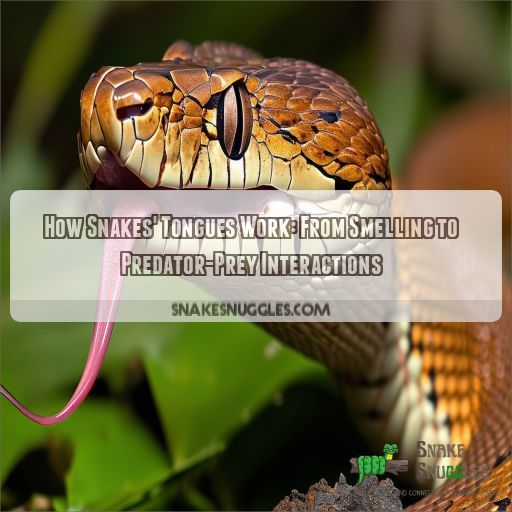This site is supported by our readers. We may earn a commission, at no cost to you, if you purchase through links.

You’ll discover how a snake’s tongue works, collecting airborne molecules and transferring them to specialized sensory organs. Learn about the evolutionary advantages of this unique adaptation and how it impacts predator-prey interactions.
Uncover the fascinating science behind snakes’ 3-D "smelling" abilities and their vital role in survival.
Table Of Contents
- Key Takeaways
- How Does a Snakes Tongue Work?
- The Function of Snake Tongues
- The Role of Snake Tongues in Chemical Detection
- The Evolutionary Advantage of Forked Tongues
- Understanding Snake Tongue Oscillation
- Snake Tongues’ Role in Predator-Prey Interactions
- The True Function of Snake Tongues
- Frequently Asked Questions (FAQs)
- How do snakes use their tongue to locate prey?
- Do snakes stick their tongue out to smell?
- Why is the snake’s tongue forked?
- Is the snake’s tongue poisonous?
- Can snakes taste with their tongues?
- How often do snakes flick their tongues?
- Do all snake species have forked tongues?
- Can snakes use their tongues underwater?
- Are snake tongues sensitive to touch?
- Conclusion
Key Takeaways
- Snake tongues are like nature’s GPS on steroids – they’re forked chemical detectors that give these slithery creatures a 3-D "smelling" ability. Talk about having your cake and eating it too!
- These remarkable tongues don’t just sit pretty – they’re workhorses, flicking up to 20 times a minute to collect airborne molecules. It’s like having a built-in vacuum cleaner for scents!
- The tongue-flicking isn’t just for show – it creates tiny whirlwinds that pull in odors, making snakes the ultimate smell connoisseurs. Who needs a wine tasting when you’ve got snake tongue action?
- Forget about simple smelling – snake tongues transfer collected molecules to specialized sensory organs, giving them a competitive edge in hunting, mate-finding, and survival. It’s like having a superpower, but instead of flying, you’re just really, really good at smelling things.
How Does a Snakes Tongue Work?
A snake’s tongue works as a sophisticated chemical sensor, collecting and transferring molecules to specialized organs. When a snake flicks its forked tongue, it’s gathering information about its environment to help them track down prey
. The tongue picks up chemical particles from the air or ground and delivers them to the Jacobson’s organ in the roof of the mouth. This organ processes the chemical information, allowing the snake to "smell" its surroundings with incredible precision.
The forked shape of the tongue enables snakes to detect chemical gradients, providing a 3-D sense of smell. This remarkable adaptation helps snakes navigate, find prey, and detect potential mates.
There’s more to this fascinating sensory system than meets the eye.
The Function of Snake Tongues
A snake’s tongue plays a fundamental role in collecting and transferring chemicals. By depositing molecules on pads in the mouth, it effectively delivers them to Jacobson’s Organ for detection.
Collecting Chemicals
Snakes collect chemicals from the air or ground with their tongues. They detect chemical gradients, which help them navigate and follow trails. This is called 3-D smelling and is similar to how owls detect sound. Male garter snakes, for example, use their tongues to follow female pheromone trails.
Transferring Molecules to Jacobson’s Organ
After snakes have collected chemicals with their tongues, they transfer these molecules to Jacobson’s organ, which is located on the roof of their mouths. This process is essential for odor detection and sensory perception in snakes.
- Snakes’ tongues are indispensable for transferring molecules to Jacobson’s organ, aiding in odor detection.
- Jacobson’s organ, located on the roof of the mouth, is paramount to a snake’s sense of smell.
- This process allows snakes to detect ground particles and chemical gradients.
- Snakes can follow pheromone trails left by potential mates, an advantage in reproduction.
- The tongue’s role in molecule transfer contributes to a snake’s ability to navigate and locate prey.
Forked Tongue for 3-D Smelling
Now, let’s delve into the captivating world of 3-D sensing through snake tongues. Their forked tongues provide an exceptional ability to detect chemical gradients, which acts as a navigational system for snakes, enabling them to follow trails with precision. This capability is particularly advantageous for male garter snakes when they’re actively seeking female pheromone trails. It’s like having an innate compass that never steers them wrong!
| Feature | Description |
|---|---|
| 3-D Sensing | Snakes’ forked tongues allow them to sense chemical gradients in three dimensions, providing directional information. |
| Chemical Gradients | Snakes can detect changes in chemical concentrations, helping them follow trails and locate prey or mates. |
| Trail-Following | By sensing chemical gradients, snakes can maintain their course, similar to how humans use a map. |
| Prey Location | Snakes use their tongues to detect prey by sensing chemical cues, especially in low-light conditions or dense vegetation. |
| Mate Detection | Male snakes, like the garter snake, use their tongues to follow female pheromone trails, increasing their chances of finding a mate. |
The Role of Snake Tongues in Chemical Detection
Snakes use their forked tongues to detect chemical gradients in the environment, allowing them to sense the presence of prey, predators, and potential mates. By flicking their tongues, snakes can gather information about their surroundings and follow scent trails, giving them a significant advantage in hunting and reproduction.
Smelling and Chemical Gradients
Snakes’ tongues are their secret weapon for exploring their surroundings. They’re nature’s chemical detectors, and here’s how they operate:
- Chemical Collection: Snakes’ tongues are like nature’s vacuum cleaners, sucking up odor molecules from the air and ground.
- Vortex Creation: When they flick their tongues, they create tiny whirlwinds (vortices) that pull in odors, making it easier to detect and analyze them.
- Jacobson’s Organ: The tongue then transfers these molecules to the Jacobson’s Organ on the roof of their mouth, which acts like a super-sensitive lab, analyzing the chemicals.
- 3-D Smelling: The forked tongue gives snakes a directional sense of smell, almost like having a GPS. They can follow chemical trails and create scent maps of their environment.
- "Stereo" Smell: Each tongue tip delivers molecules to its own Jacobson’s Organ, providing a dual-channel smell system for enhanced odor detection and exploration.
Sensing Surroundings and Predators
Snakes use their tongues to sense their surroundings and detect predators.
This behavior, known as tongue-flicking, serves multiple purposes. It helps snakes gather information about their environment, detect chemicals in the air, identify prey, and locate potential mates.
Additionally, tongue-based communication allows snakes to exchange information with other snakes, such as signaling danger or establishing territorial boundaries.
The tongue also plays a role in thermoregulation, acting as a heat exchanger to regulate body temperature.
These reflexes showcase the adaptability and survival instincts of snakes, contributing to their ecological success.
Trail-Following and Mate-Finding
Snakes possess an exceptional ability to navigate scent trails, and their tongues play a fundamental role in this process. This assists them in not only locating prey but also in finding potential mates. The process of trail-following entails the detection of chemical gradients, which provide snakes with directional information.
Here’s an in-depth examination of the role of snake tongues in trail-following and mate-finding:
- Sexual dimorphism: Male garter snakes exhibit a remarkable example of sexual dimorphism. They utilize their tongues to follow the pheromone trails of female snakes, with specific tongue movements guiding them along the trail.
- Pheromone detection: Snakes’ tongues are highly receptive to chemical signals, including pheromones released by potential mates. This allows them to detect and identify suitable partners.
- Trail-following: The ability to detect chemical gradients is essential for trail-following. Snakes can follow scent trails left by prey or potential mates, using their tongues to detect even subtle changes in chemical concentrations.
- Jacobson’s organ: Located on the roof of the mouth, Jacobson’s organ is a specialized sensory structure. It detects chemicals deposited by the tongue, providing snakes with information about their surroundings and potential mates.
The Evolutionary Advantage of Forked Tongues
Snakes’ evolution of forked tongues gives them a distinct advantage, allowing for acute chemical detection in low-light conditions. This adaptation has driven their diversification and success through natural selection, ensuring they outcompete other species in hunting and reproduction.
Adaptation to Low-Light Conditions
Snakes’ forked tongues provide a distinct evolutionary advantage, particularly in low-light conditions. This adaptation enhances their ability to navigate and forage efficiently, contributing to their overall success as predators.
| Advantage | Description |
|---|---|
| Foraging Efficiency | Snakes can locate prey and detect chemical gradients, even in low-light environments, increasing their hunting success. |
| Escape Strategies | The ability to sense surroundings and detect predators early on improves snakes’ chances of survival. |
| Habitat Selection | Enhanced sensory capabilities allow snakes to select suitable habitats, balancing access to prey and safety from predators. |
Diversification and Success
The forked tongue is a testament to the evolutionary prowess of snakes.
This innovative trait has facilitated their expansion and adaptability across diverse ecosystems.
By employing their tongues as sophisticated chemical detectors, snakes have carved out a unique ecological niche for themselves.
This specialized organ enhances their survival tactics, such as locating prey and potential mates, solidifying their status as formidable predators in a variety of habitats.
Natural Selection and Snake Tongues
The evolutionary advantage of forked tongues in snakes is a demonstration of natural selection’s power. It aided snakes in navigating the ancient world, evading dinosaurs, and locating underground refuge. This highly acute sense of smell in low-light conditions has contributed to the ecological success and diversification of snakes.
Understanding Snake Tongue Oscillation
Snake tongues oscillate to generate air vortices, enhancing their ability to collect odor molecules. This mechanism allows them to smell airborne chemicals more effectively by concentrating and accelerating odor collection.
Generating Vortices for Odor Collection
The forked tongue of snakes isn’t just for show—it’s a key tool in their survival kit. Snakes oscillate their tongues to generate air vortices, which boost odor concentration near their tongues. This clever trick enhances their ability to detect airborne odors, improving their chances of finding prey or potential mates.
Smelling Airborne Odors
Snakes possess an exceptional ability to detect airborne odors, which is essential for their survival and reproductive success. Their forked tongues create vortices that pull in odors from the air, allowing them to sample these chemical signals efficiently. This odor collection mechanism enhances their sense of smell and helps them navigate, find prey, and locate potential mates.
Concentrating and Accelerating Odor Molecules
Snakes have a unique ability to concentrate and accelerate odor molecules, enhancing their sense of smell. Here’s how:
- Odor collection: Snakes use their forked tongues to collect odor molecules from the air or ground.
- Vortex generation: By oscillating their tongues, snakes create vortices (like tiny whirlwinds) that pull in odors and keep them close.
- Odor concentration: Vortices effectively concentrate odors, making them easier to detect.
- Odor acceleration: Tongue motion speeds up odor collection, aiding quick analysis.
- Airborne chemical detection: This enables efficient detection and identification of airborne chemicals, from pheromones to prey scents.
Snake Tongues’ Role in Predator-Prey Interactions
Your snake’s forked tongue gives it a competitive edge when hunting prey in low-light conditions or dense vegetation. By detecting chemical trails, your snake can effectively locate and track down potential mates, giving it a reproductive advantage over other snakes.
Locating Prey in Low-Light Conditions
The tongue is a snake’s secret weapon. It helps them locate prey in low-light conditions and dense vegetation.
It is like having night vision and GPS combined.
With their tongues, snakes can detect scent trails, which aids in hunting in challenging environments.
This ability to follow scent trails and navigate complex terrain gives snakes a competitive edge, contributing to their ecological success.
Detecting Potential Mates
Snakes use their tongues to detect potential mates.
Male garter snakes, for example, follow female pheromone trails to locate their partners.
This is achieved by sensing chemical gradients, which guides their navigation.
The forked tongue enables them to determine when one tip has strayed from the trail, indicating the need to adjust their path.
The tongue plays a crucial role in mate location, pheromone detection, and species identification, all of which are essential for successful courtship and sexual signaling behaviors.
Competitive Advantage in Hunting
Snakes’ tongues give them a competitive advantage when hunting.
Their tongues help them locate prey, even in low-light conditions or dense vegetation.
Their tongues also aid in reproductive success. Snakes can detect mates and identify the sex of potential partners through taste. Males can follow female pheromone trails.
This ability to sense chemical signals enhances their ecological success.
The True Function of Snake Tongues
The true function of snake tongues involves collecting and transporting molecules to the vomeronasal organs, which are specialized olfactory organs like the Jacobson’s organ. By separating their tongue tips, snakes enable a stereo smell mechanism that’s also seen in fork-tongued lizards.
Vomeronasal Organs and Olfactory Sensitivity
The true function of snake tongues is to collect and transport molecules to specialized organs for olfactory sensitivity.
Contrary to popular belief, snake tongues are not primarily used for tasting, but for smelling.
This is made possible by the vomeronasal organs, located on the roof of the mouth, which are highly sensitive to chemicals.
By oscillating their tongues, snakes create air vortices, efficiently directing odor molecules to these sensory organs.
This process enhances their chemical detection abilities, providing snakes with a "stereo" sense of smell. This heightened olfactory sense aids snakes in navigating their environment and locating prey or potential mates.
Separation of Tongue Tips for Stereo Smell
Snakes have evolved a unique tongue morphology that enables them to detect chemical gradients with precision. This sensory acuity allows them to follow pheromone trails left by potential mates or prey.
By separating their tongue tips, they create a stereo smell effect, enhancing their ability to navigate and locate food or predators.
This separation of tongue tips is a key adaptation for survival, especially in low-light conditions or complex terrain, where it aids predator avoidance and successful hunting.
Fork-Tongued Lizards’ Similar Mechanism
You’ll find that fork-tongued lizards share a similar mechanism to snakes. Their forked tongues also serve as advanced olfactory organs, capable of detecting chemical gradients. Like snakes, these lizards use their tongues to collect odor molecules from their environment.
This adaptation plays a key role in predator-prey interactions, helping them locate food and avoid becoming someone else’s dinner. It’s nature’s way of giving them an edge in survival.
Frequently Asked Questions (FAQs)
How do snakes use their tongue to locate prey?
You’ll see snakes flick their forked tongues to collect chemical particles from the air and ground. They’re actually "tasting" their surroundings, using this info to pinpoint prey’s location and follow scent trails with impressive accuracy.
Do snakes stick their tongue out to smell?
Yes, snakes stick out their forked tongues to smell. You’ll see them flicking their tongues to collect chemical particles from the air and ground. They’re fundamentally tasting their environment to locate prey, mates, and potential threats.
Why is the snake’s tongue forked?
You’d think snakes were indecisive, but their forked tongue‘s no joke. It’s nature’s GPS, letting them smell in stereo. They’re tracking chemicals from two directions, giving them a precise sense of their surroundings. Pretty slick, huh?
Is the snake’s tongue poisonous?
No, your snake’s tongue isn’t poisonous. It’s a sensory organ, not a weapon. You’ll find it’s used for "smelling" the environment, gathering chemical information, and helping your snake navigate its surroundings effectively.
Can snakes taste with their tongues?
Ever wondered about a snake’s secret weapon? You’d be surprised to learn their tongues aren’t for tasting. They’re actually smell collectors, gathering scent particles and delivering them to special organs for analysis. It’s like having a built-in chemistry lab!
How often do snakes flick their tongues?
You’ll notice snakes flick their tongues frequently, especially when exploring or hunting. The rate varies by species and situation, ranging from once every few seconds to several times a minute. It’s their way of "smelling" the world.
Do all snake species have forked tongues?
You’ll find that nearly all snake species have forked tongues. It’s a key feature that’s evolved across the snake family. The fork’s depth can vary, but it’s present in most species you’ll encounter.
Can snakes use their tongues underwater?
Yes, snakes can use their tongues underwater. You’ll find they flick their forked tongues to sample chemicals in water, just as they do on land. This helps them detect prey and navigate aquatic environments efficiently.
Are snake tongues sensitive to touch?
You’d be surprised, but snake tongues aren’t very touch-sensitive. They’re specialized for chemical sensing, not tactile exploration. When a snake’s tongue flicks, it’s gathering scent molecules, not feeling its surroundings. It’s all about smell, not touch!
Conclusion
Did you know that snakes flick their tongues up to 20 times per minute? This fascinating behavior showcases how a snake’s tongue works as a sophisticated chemical detector.
You’ve learned how these forked organs collect airborne molecules, transfer them to specialized sensory organs, and provide 3-D "smelling" abilities. This unique adaptation gives snakes a competitive edge in hunting, mate-finding, and survival.
Understanding snake tongues offers insight into the incredible ways nature has evolved to overcome challenges and thrive in diverse environments.












